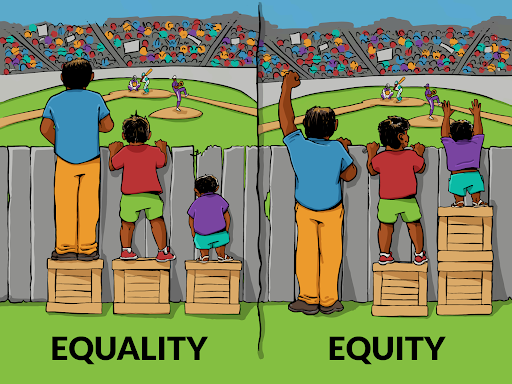Diversity is a fact. Equity is a choice. Inclusion is an action. Belonging is an outcome.–Arthur Chan
Diversity is about who attends Montclair, and who attends your classes.
Equity is about making the playing field of your classroom equal to all students through your work engaging students and being responsive to inequitable outcomes.
Inclusion is about ensuring that all students are respected, integrated, and successful at Montclair and in your class.
Belonging is about ensuring all students believe they are truly legitimate students in your class, the discipline, and at Montclair.
Using inclusive teaching strategies and cultivating an inclusive classroom climate not only helps all students learn but also prepares them for the world beyond the University. Students who become familiar with inclusive teaching become more open-minded and empathetic, more knowledgeable about other points of view, better prepared for a diverse workplace environment.
Few instructors oppose an inclusive classroom climate, but it can be hard to know where to start. Some ideas:
Diversity = Recognizing who is in your class
Get to know the students in the classroom and at Montclair:
- Know your students. Before the semester begins, review your roster and study student profiles. Get a sense of who is in your class. Review summary information about Montclair students more broadly. See also, “What’s In a Name?” a study that explores the value of students perceiving that instructors know their names, even in large classes. Struggling with names? Name tents and class seating maps are helpful tools.
- Ask students about themselves in a survey. Simple questions like the following are designed to support connection, underscore that you see students as whole people, and elicit concerns that you may be able to address.
- What is going well for you this semester?
- What is causing you worry or trouble?
- Is there anything that I can do, as your instructor, to help with these worries?
- What are your grateful? What or who gives you the strength and encouragement to persevere?
- Develop an introductory assignment that invites students to show themselves and not assume a “generic student” posture. Ask students to complete an early assignment introducing themselves to you, conveying relevant past experiences with learning, and indicating any anxieties or concerns going into the course. Offer light feedback that shows you’ve read their work and understand any concerns.
- Share about your own identity, and how aspects of your identity influence your learning, your understanding of the subject of your course, etc.
- Encourage introspection and sharing about individual perspectives and how they are shaped by culture and upbringing: “Why do you think you think what you think?”
Equity = Making the playing field of your classroom equal

Image from: Interaction Institute for Social Change, Artist: Angus Maguire
Equity-minded teachers:
- Watch for inequity, including patterns of silence, disengagement, exclusion
- Seek feedback and perspectives from students
- Experiment with different methods of teaching and assessment
Equity minded teachers:
- Communicate course requirements early — including resources needed.
- Proactively support students who are struggling with resources.
- Observe their “assumed knowledge” — is it equitable? biased?
- Diversify references & examples
- Define cultural references
- Check-in on assumed knowledge
- Vary their assignments & assessments so that all students can have that “perfect assignment for me” experience at least sometimes.
- Are thoughtful with their carrots & sticks — if they are having unintended consequences, re-think.
Inclusion = Ensuring that all students are respected, integrated, and successful
1. Course content check
- Are there multiple perspectives on course topics?
- Do you see diversity in creators & authors?
- Do you provide views of various people?
- Are you impressed with the representation of others by selected authors? That is, an author is just one person, but is that author writing about many perspectives?
2. Pedagogical Approach
- Observe and call attention to exclusive perspectives and approaches in course content
- Ask students directly: whose perspective might be missing here?
- Observe and disrupt patterns of dominance
- Seek out one-to-one interactions with students who appear excluded, even if they appear self-excluded.
- Offer students choice in how they demonstrate learning and mastery (offer options for assessment types, either within one assessment or across the semester; that is, not all quizzes, but quizzes, discussion board posts, multi-moda projects, and the like).
Belonging = Ensuring that all students at MSU feel valued, accepted & legitimate at MSU and in your class
Foster Belonging
09.08.22
For more information or help, please email the Office for Faculty Excellence or make an appointment with a consultant.
![]()
Teaching Resources by Montclair State University Office for Faculty Excellence is licensed under a Creative Commons Attribution-NonCommercial 4.0 International License
Third-party content is not covered under the Creative Commons license and may be subject to additional intellectual property notices, information, or restrictions. You are solely responsible for obtaining permission to use third party content or determining whether your use is fair use and for responding to any claims that may arise.
